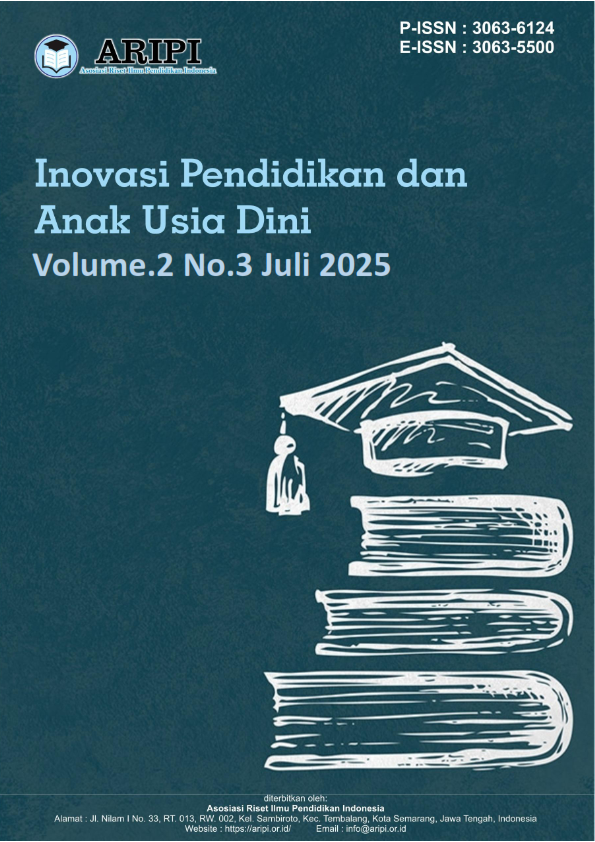Pemaknaan Belajar Anak Non Disabilitas Bersama Teman Penyandang Disabilitas di Kelas Inklusif di Tk Sukma Nusa Bangsa
DOI:
https://doi.org/10.61132/inpaud.v2i3.458Keywords:
Inclusive Class, non-disabled children, disability, meaning of learning, inclusive educationAbstract
This study aims to reveal how non-disabled children interpret their learning experiences with friends with disabilities in inclusive classes. Inclusive classes are educational environments that combine non-disabled and disabled students in the same learning space, with the hope of creating equal and respectful interactions. The method used in this study is a qualitative approach with observation and data collection techniques. The results of the study show that non-disabled children interpret their learning experiences not only as an academic process, but also as a social and emotional learning process. They learn about empathy, tolerance, and cooperation, and show changes in attitudes towards diversity.
References
Adiputra, S. (2020). Psikologi perkembangan anak usia dini dalam perspektif Islam. Jakarta: Rajawali Pers.
Bowlby, J. (1969). Attachment. New York: Basic Books.
Fletcher, J. M. (2009). Spillover effects of inclusion of classmates with emotional problems on test scores in early elementary school. Journal of Policy Analysis and Management, 28(3), 447–463. https://doi.org/10.1002/pam.20440
Handayani, T., & Rahadian, A. S. (2013). Peraturan perundangan dan implementasi pendidikan inklusif. Masyarakat Indonesia, 39(1), 149701.
Hasanah, L., Zahra, K. A., Awaliah, M. U., Fakhriyyah, B. H., & Kusmiratun, F. (2023). Konsep belajar anak usia dini menurut perspektif umum dan perspektif Islam. Jurnal PAUD Agapedia, 8(1), 73–82.
Jardinez, M. J., & Natividad, L. R. (2023). The advantages and challenges of inclusive education: Striving for equity in the classroom. Shanlax International Journal of Education, 11(2), 57–65. https://doi.org/10.34293/education.v11i2.5773
Khotimah, S. H., Sunaryati, T., & Suhartini, S. (2020). Penerapan media gambar sebagai upaya dalam peningkatan konsentrasi belajar anak usia dini. Jurnal Obsesi: Jurnal Pendidikan Anak Usia Dini, 5(1), 676–682. https://doi.org/10.31004/obsesi.v5i1.571
Khuzaimah, U. (2009). Konsep belajar sepanjang hayat. Bandung: Alfabeta.
Margiathi, S. A., Lerian, O., Wulandari, R., Putri, N. D., & Musyadad, V. F. (2023). Dampak konsentrasi belajar terhadap hasil belajar peserta didik. Jurnal Primary Edu, 1(1), 61–68.
Mulyasa, E. (2013). Manajemen dan kepemimpinan kepala sekolah. Jakarta: Bumi Aksara.
Nugroho, D. (2017). Strategi pembelajaran inklusif untuk anak berkebutuhan khusus. Jurnal Ilmiah Pendidikan Khusus, 5(2), 100–108.
Rooselina, R., & Fitria, T. N. (2022). Peningkatan motivasi belajar anak usia dini melalui pendekatan bermain peran. Jurnal Golden Age, 6(1), 34–42.
Sari, D. K., & Lestari, M. (2021). Implementasi pendidikan karakter pada anak usia dini dalam lingkungan keluarga. Jurnal Pendidikan Anak Usia Dini, 5(2), 75–84.
Suharsimi, A. (2010). Prosedur penelitian: Suatu pendekatan praktik (Edisi revisi). Jakarta: Rineka Cipta.
Susanto, A. (2017). Perkembangan anak usia dini: Pengantar dalam berbagai aspek. Jakarta: Kencana.









